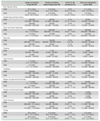Abstract
The number of people living with HIV/AIDS continues to grow, estimated to be 39.5 million as of the end of 2006, while 4.3 million people were newly infected in 2006. The proportions of women has continued to grow, currently approaching 50%. Sub-Saharan Africa continues to bear the brunt of global epidemic, comprising 63% of all infections worldwide. The most striking increases have occurred in East Asia, Eastern Europe, and Central Asia. High-risk behaviors (intravenous drug use and unprotected sex between men or with paid sex workers) are the predominant route of transmission. The number of people with HIV/AIDS continues to increase since the first report of HIV in Korea, now approaching 4,580 as of the end of 2006. The real magnitude of HIV epidemic is believed to be much larger than the recent estimates by UNAIDS shows (13,000 people with HIV infection). The prevalence among the general population is still low (less than 0.1%; probably 0.003~0.01%). The HIV epidemic in Korea shows several peculiar features: 1) a male predominance suggesting that the epidemic may still be largely confined to male homosexual community, while the transmission through heterosexual contact remains less prominent, 2) a conspicuous absence of contribution of intravenous drug use to current epidemic, and 3) a very small number of vertical transmission due to the relatively limited number of infected women. The HIV epidemic is expected to continue to grow in the foreseeable future in Korea as well as globally unless drastic efforts are made to cope with the epidemic.
Figures and Tables
References
1. UNAIDS. AIDS epidemic update: special report on HIV/AIDS: December 2006. 2006. Geneva: UNAIDS/WHO.
2. Country HIV and AIDS estimates. UNAIDS. 2006. Available at http://www.unaids.org/geographical+area/by+country/republic+of+korea+.asp.
3. Kim O, Kim S. Seroprevalence of sexually transmitted viruses in Korean populations including HIV-seropositive individuals. Int J STD AIDS. 2003. 14:46–49.

4. Oh MD, Choe KW. Epidemiology of HIV infection in the republic of Korea. J Korean Med Sci. 1999. 14:469–474.

5. Oh MD, Kim NJ, Lee EB, Kim YS, Peck KR, Choe KW. Seroprevalence of HIV infection in patients with sexually transmitted diseases. Korean J Infect Dis. 1998. 30:94–96.
6. Kim JM, Cho GJ. Epidemiology and clinical features of HIV/AIDS in Korea. Yonsei Med J. 2003. 44:363–370.

7. Shin S. Commercial sex-worker's condom use behavior in Korea. Taehan Kanho Hakhoe Chi. 2004. 34:1477–1482.
8. KCDC. Report on the Korean people newly infected with HIV/AIDS in 2006. CDMR. 2006. 17:10.
9. Kim S. Plan of HIV/AIDS cohort in Korea. 2006. In : 8th International AIDS Symposium; 15 September.




 PDF
PDF ePub
ePub Citation
Citation Print
Print





 XML Download
XML Download